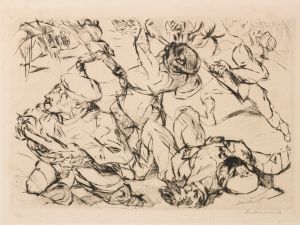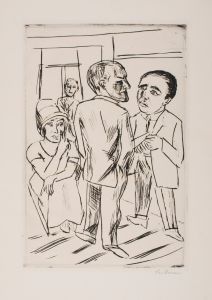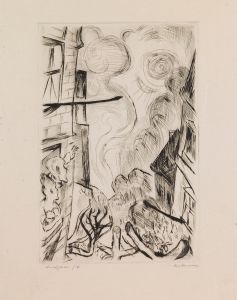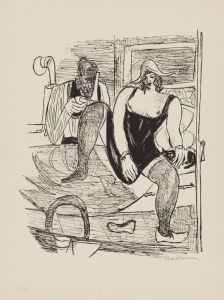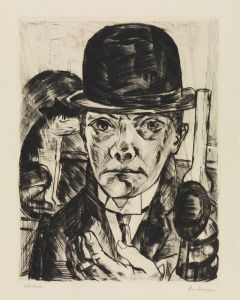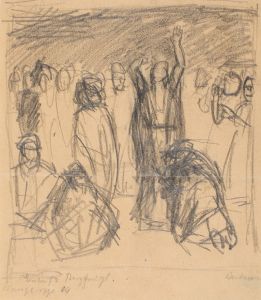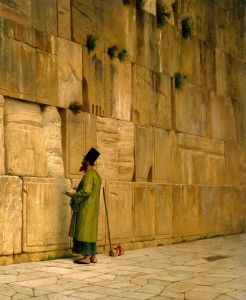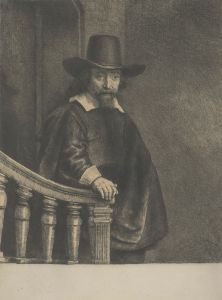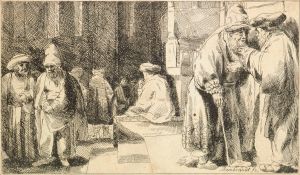
The Synagogue in Frankfurt am Main
A hand-painted replica of Max Beckmann’s masterpiece The Synagogue in Frankfurt am Main, meticulously crafted by professional artists to capture the true essence of the original. Each piece is created with museum-quality canvas and rare mineral pigments, carefully painted by experienced artists with delicate brushstrokes and rich, layered colors to perfectly recreate the texture of the original artwork. Unlike machine-printed reproductions, this hand-painted version brings the painting to life, infused with the artist’s emotions and skill in every stroke. Whether for personal collection or home decoration, it instantly elevates the artistic atmosphere of any space.
Max Beckmann's painting "The Synagogue in Frankfurt am Main" is a significant work that reflects both the artist's personal history and the broader socio-political context of early 20th-century Germany. Max Beckmann, a German painter, draftsman, printmaker, and sculptor, is often associated with the New Objectivity movement, which emerged in Germany in the aftermath of World War I. This movement was characterized by a realistic style combined with a critical social commentary.
"The Synagogue in Frankfurt am Main" was painted in 1919, a time when Beckmann was living in Frankfurt. This period was marked by significant upheaval and change in Germany, following the end of World War I and the beginning of the Weimar Republic. The painting depicts the Westend Synagogue, one of the largest and most prominent synagogues in Frankfurt, which was completed in 1910. The synagogue was a symbol of the vibrant Jewish community in Frankfurt, which was one of the largest in Germany at the time.
Beckmann's depiction of the synagogue is notable for its expressionistic style, characterized by bold colors and dynamic forms. The painting captures the grandeur and architectural beauty of the synagogue, while also conveying a sense of unease and tension. This reflects Beckmann's own experiences and the broader societal tensions of the time, including the rise of anti-Semitism and the challenges faced by the Jewish community in Germany.
The painting is also significant in the context of Beckmann's personal life. Although not Jewish himself, Beckmann had many Jewish friends and colleagues, and he was deeply affected by the social and political changes occurring in Germany. His work often reflects a deep empathy for the marginalized and a critique of the societal norms of his time.
"The Synagogue in Frankfurt am Main" is part of a larger body of work by Beckmann that explores themes of identity, displacement, and the human condition. His paintings from this period often feature urban landscapes and architectural structures, which serve as metaphors for the complexities of modern life.
The historical significance of the painting is further underscored by the events of the Holocaust, during which many synagogues in Germany, including the Westend Synagogue, were damaged or destroyed. The Westend Synagogue, however, survived the Kristallnacht pogrom in 1938, although it was later damaged during World War II. It was restored and remains a functioning synagogue today, serving as a testament to the resilience of the Jewish community in Frankfurt.
Max Beckmann's "The Synagogue in Frankfurt am Main" thus stands as a powerful work of art that captures a moment in history, reflecting both the personal vision of the artist and the broader historical and cultural context of early 20th-century Germany. The painting is a poignant reminder of the rich cultural heritage of the Jewish community in Frankfurt and the enduring impact of Beckmann's artistic legacy.








